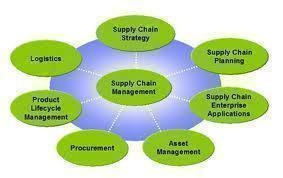Supply Chain Management
Supply chain management (SCM) is the management of a connection of numerous different businesses that brings a raw resource and converts it into a final product that is then delivered to a customer. In other words, it is the process in which the supply of a good is provided. It starts as an idea, moves to the production stage which brings in raw goods, heads to the packaging stage and then completes with the sale of the good. The SCM of this would be the managers responsible for bringing this product or service to fruition.
Problems Addressed by Supply Chain Management
There are a series of problems that SCM addresses. These include:
- Distribution Network Configuration: The number and location of the supplies, distributors and customers.
- Distribution Strategy: How are the goods getting from the factory to the warehouse? Are the trucks privately owned or owned by third party companies? This is the strategy in which a product goes from completion to the sales floor. How will it be distributed around the state, country or world?

- Trade-Offs in Logistical Activities: While it is important to determine how to get the goods around, it is also important to consider the cheapest route and when it is acceptable to go with a more expensive route. The trade-offs allows for this to be systematically controlled.
- Information: Allows for information to be shared amongst the different steps of the supply chain.
- Inventory Management: The number of finished goods, the amount of raw materials and where the goods are currently. This way, management can decide how much more to make.
- Cash-Flow: This is the way in which money flows between departments and money is given to ones that need it. For example, the department that buys raw goods is going to need money to get the goods.
Supply Chain Management
With globalization continuing to grow, companies are finding that they are doing business with numerous different businesses to get one product made. For example, Dell might get their mother board from one company in China, but then get the memory from a company in Mexico. What SCM has allowed these companies to do is successfully integrate and control all of these companies so that the goods wind up exactly where they need to be. Without this management, goods would be flying all over the world and the companies would have to dedicate more funds and resources to logistics. Supply chain management allows for this entire process to be put on autopilot.
Supply chain management has evolved over the years to include more than just the product. While the creation of a product by one company from the resources found from another company is important, another step is the customer service. This has created another branch of supply chain management. Companies now realize that customers want to get in contact with the company to express frustrations about products. This means that there needs to be a supply of support.
Reverse Supply Chain
While SCM is the process in which a product is made and then sold, thus adding money to the reserves, Reverse Supply Chain is the process in which a product is returned. Money leaves the account of the company and therefore, the process goes in reverse. Any time that money leaves the company and a product comes back to the company, it is dubbed reverse supply chain.


Comments - No Responses to “Supply Chain Management”
Sorry but comments are closed at this time.